Strategic Decision Making for Waitrose: A Comprehensive Report
VerifiedAdded on 2020/01/28
|13
|3330
|429
Report
AI Summary
This report provides a detailed analysis of Waitrose's strategic decision-making process. It begins with an introduction to the organization, followed by a summary of internal and external factors using PESTLE and SWOT analyses, as well as Porter's Five Forces. The report then explores the development of strategic choices, focusing on the adoption of a sustainable product strategy. It evaluates these choices using SAFe analysis, assessing their suitability, acceptability, and feasibility. The report also offers recommendations for Waitrose based on prevailing market conditions, emphasizing customer demands and the importance of strategic planning in the competitive supermarket industry. The study highlights the significance of resource management and distinctive capabilities in formulating effective strategies, and addresses potential market risks. Finally, the report concludes with a comprehensive overview of the organization's strategic approach and its implications for future success.
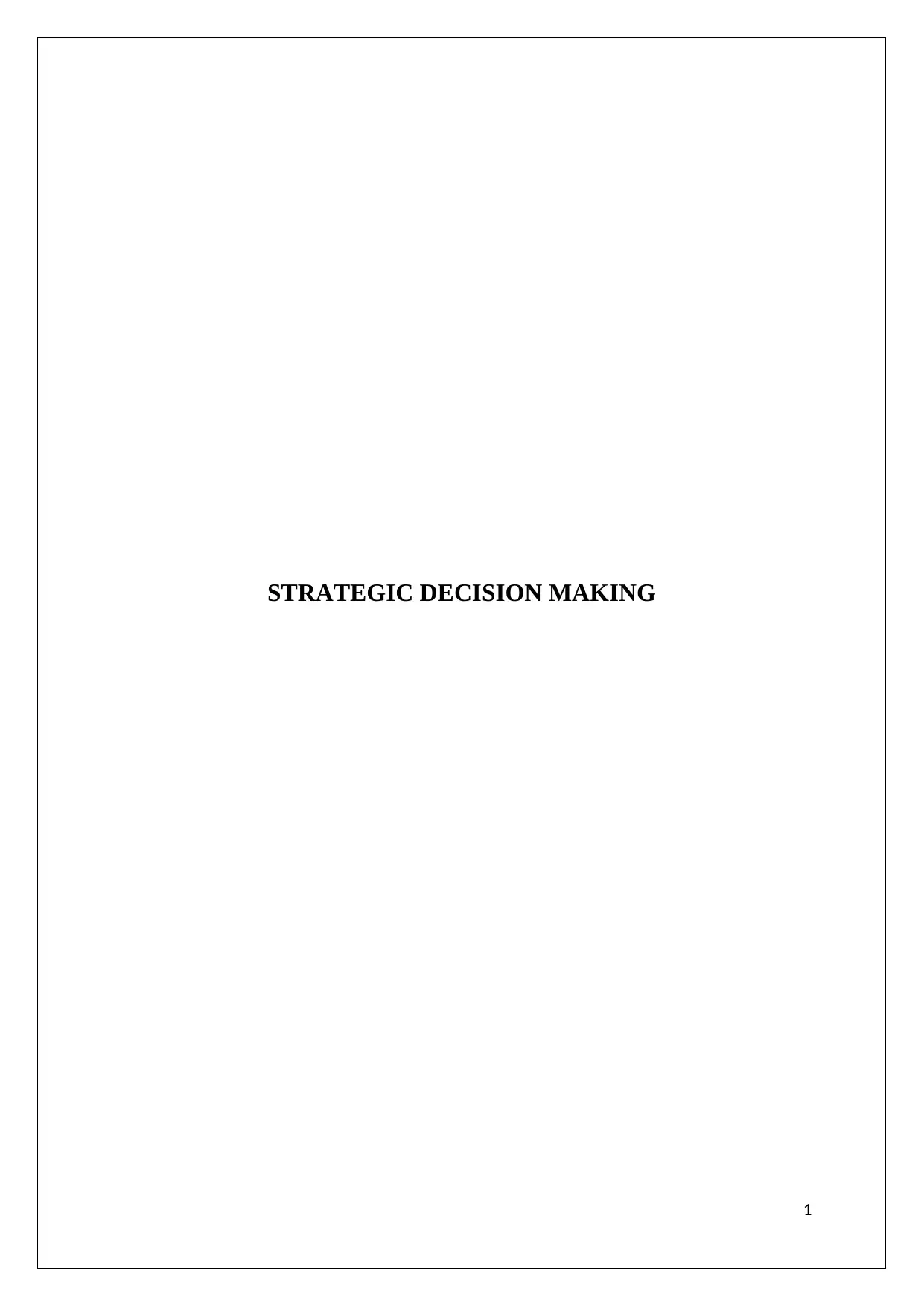
STRATEGIC DECISION MAKING
1
1
Secure Best Marks with AI Grader
Need help grading? Try our AI Grader for instant feedback on your assignments.
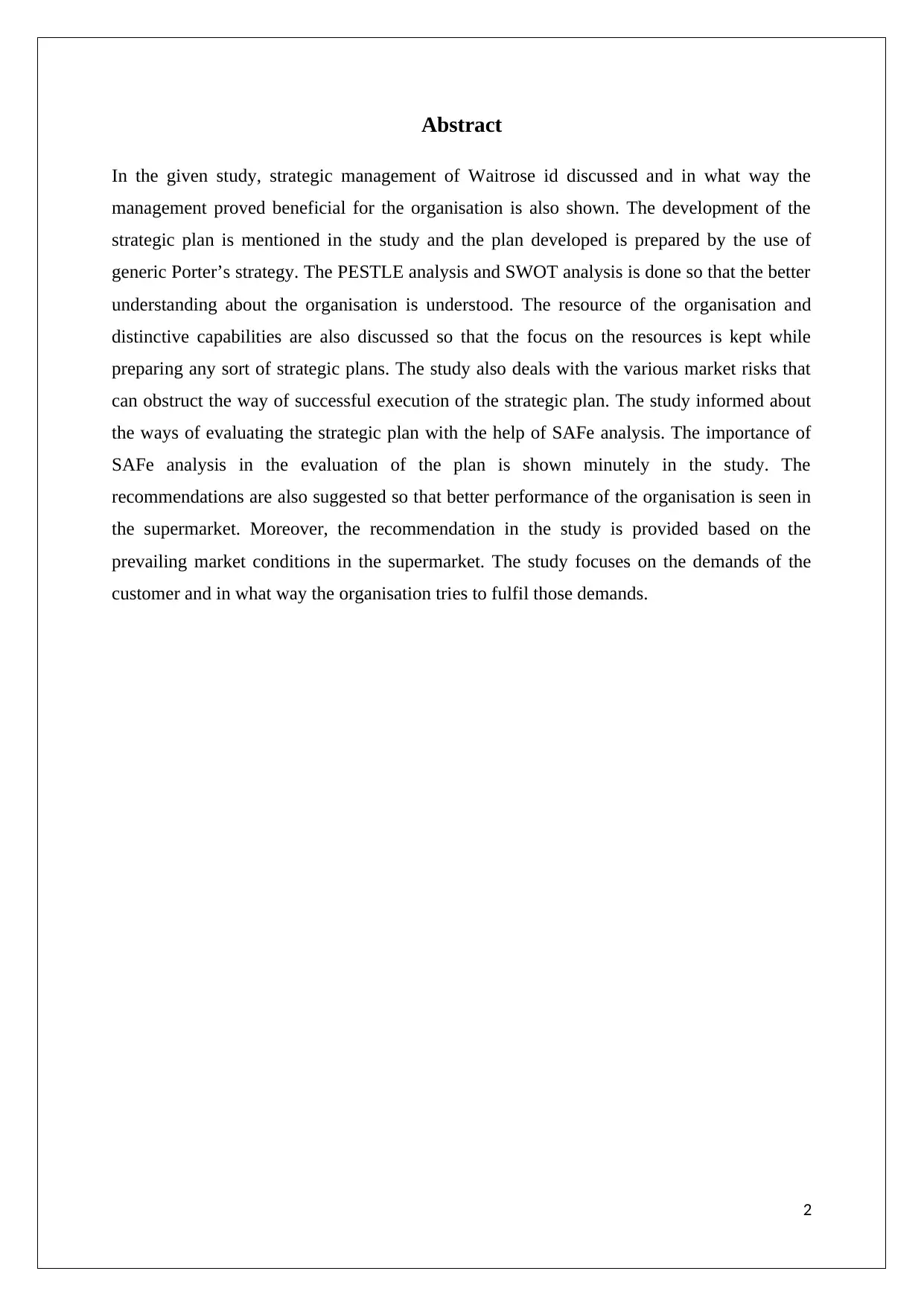
Abstract
In the given study, strategic management of Waitrose id discussed and in what way the
management proved beneficial for the organisation is also shown. The development of the
strategic plan is mentioned in the study and the plan developed is prepared by the use of
generic Porter’s strategy. The PESTLE analysis and SWOT analysis is done so that the better
understanding about the organisation is understood. The resource of the organisation and
distinctive capabilities are also discussed so that the focus on the resources is kept while
preparing any sort of strategic plans. The study also deals with the various market risks that
can obstruct the way of successful execution of the strategic plan. The study informed about
the ways of evaluating the strategic plan with the help of SAFe analysis. The importance of
SAFe analysis in the evaluation of the plan is shown minutely in the study. The
recommendations are also suggested so that better performance of the organisation is seen in
the supermarket. Moreover, the recommendation in the study is provided based on the
prevailing market conditions in the supermarket. The study focuses on the demands of the
customer and in what way the organisation tries to fulfil those demands.
2
In the given study, strategic management of Waitrose id discussed and in what way the
management proved beneficial for the organisation is also shown. The development of the
strategic plan is mentioned in the study and the plan developed is prepared by the use of
generic Porter’s strategy. The PESTLE analysis and SWOT analysis is done so that the better
understanding about the organisation is understood. The resource of the organisation and
distinctive capabilities are also discussed so that the focus on the resources is kept while
preparing any sort of strategic plans. The study also deals with the various market risks that
can obstruct the way of successful execution of the strategic plan. The study informed about
the ways of evaluating the strategic plan with the help of SAFe analysis. The importance of
SAFe analysis in the evaluation of the plan is shown minutely in the study. The
recommendations are also suggested so that better performance of the organisation is seen in
the supermarket. Moreover, the recommendation in the study is provided based on the
prevailing market conditions in the supermarket. The study focuses on the demands of the
customer and in what way the organisation tries to fulfil those demands.
2
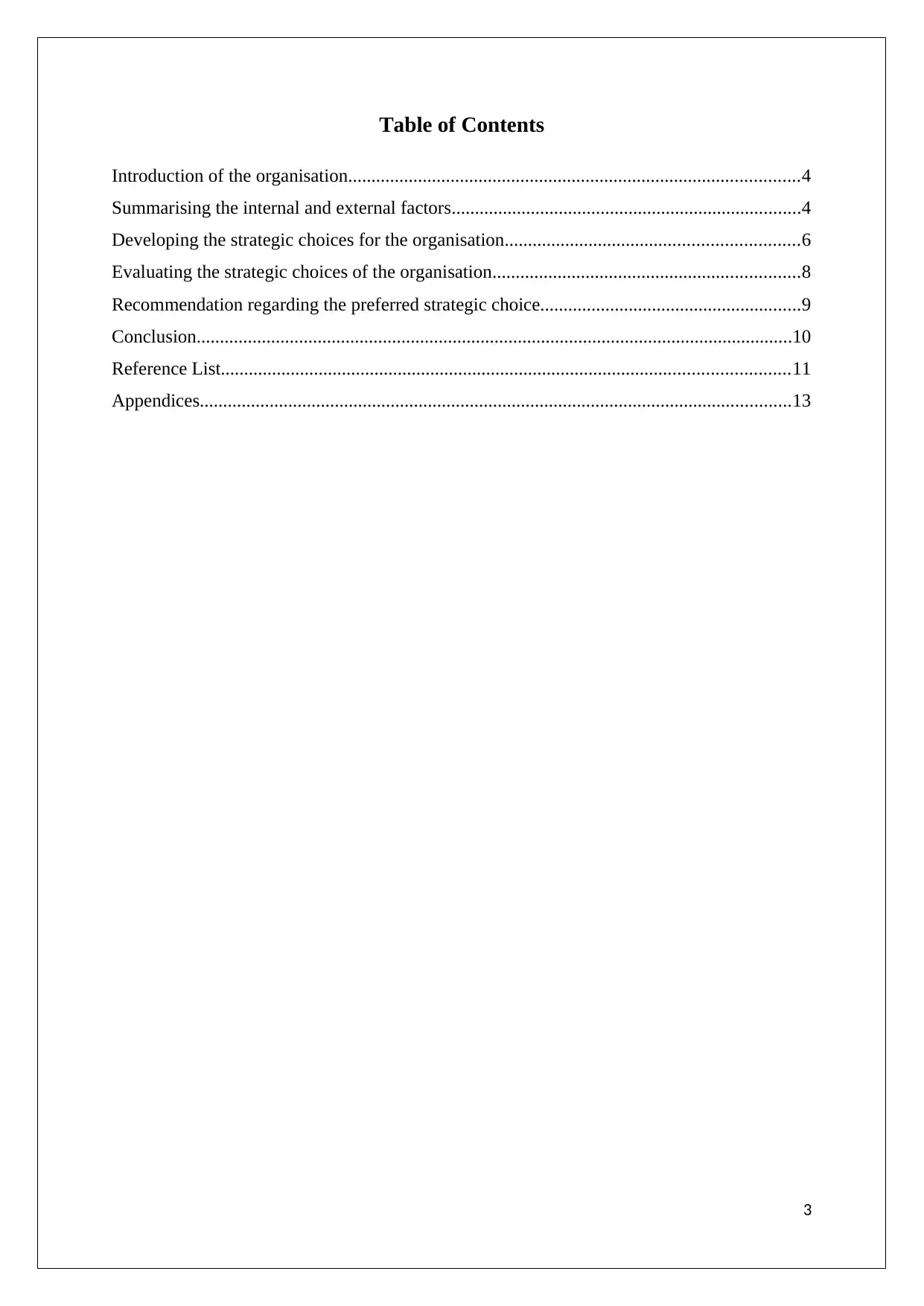
Table of Contents
Introduction of the organisation.................................................................................................4
Summarising the internal and external factors...........................................................................4
Developing the strategic choices for the organisation...............................................................6
Evaluating the strategic choices of the organisation..................................................................8
Recommendation regarding the preferred strategic choice........................................................9
Conclusion................................................................................................................................10
Reference List..........................................................................................................................11
Appendices...............................................................................................................................13
3
Introduction of the organisation.................................................................................................4
Summarising the internal and external factors...........................................................................4
Developing the strategic choices for the organisation...............................................................6
Evaluating the strategic choices of the organisation..................................................................8
Recommendation regarding the preferred strategic choice........................................................9
Conclusion................................................................................................................................10
Reference List..........................................................................................................................11
Appendices...............................................................................................................................13
3
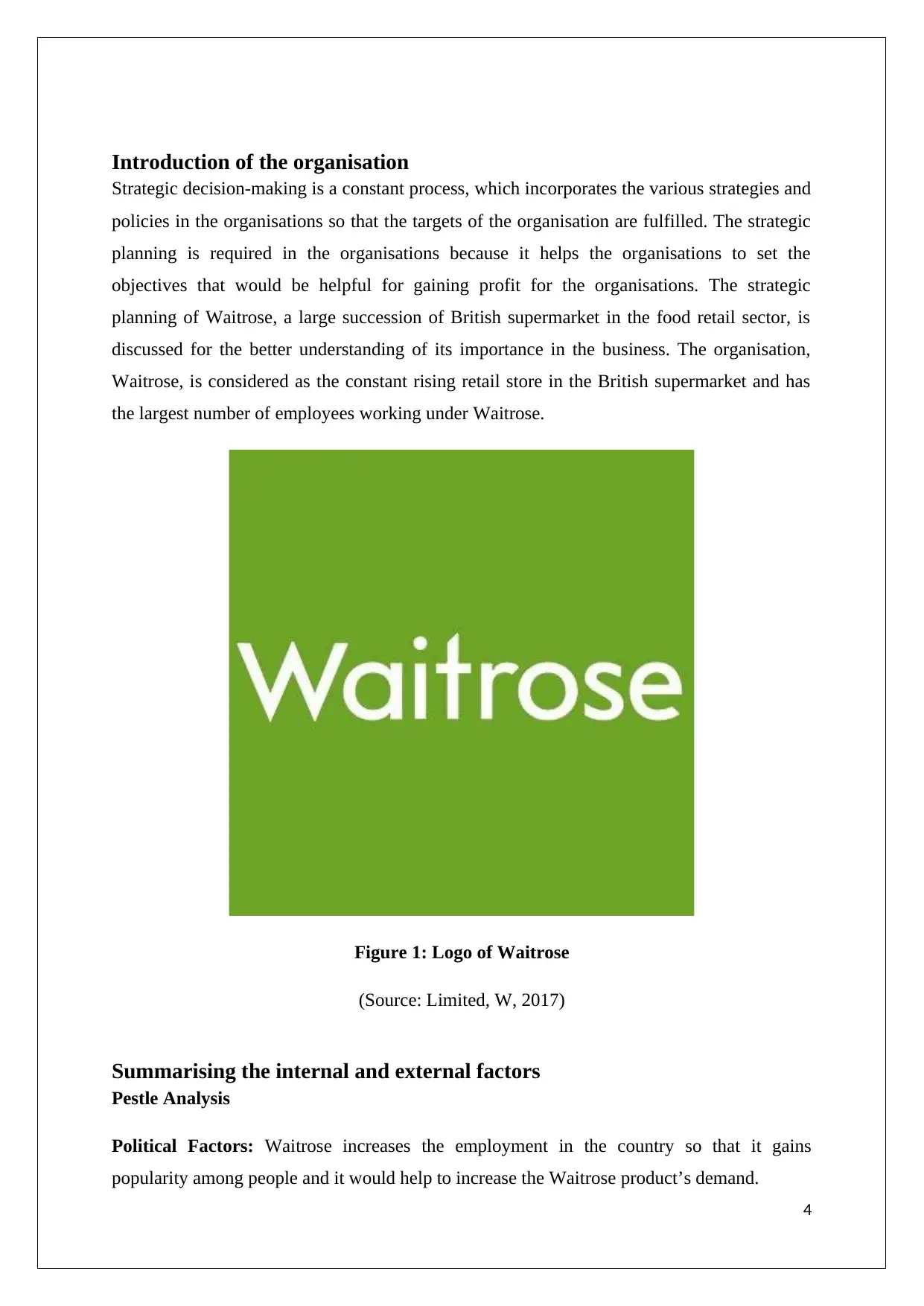
Introduction of the organisation
Strategic decision-making is a constant process, which incorporates the various strategies and
policies in the organisations so that the targets of the organisation are fulfilled. The strategic
planning is required in the organisations because it helps the organisations to set the
objectives that would be helpful for gaining profit for the organisations. The strategic
planning of Waitrose, a large succession of British supermarket in the food retail sector, is
discussed for the better understanding of its importance in the business. The organisation,
Waitrose, is considered as the constant rising retail store in the British supermarket and has
the largest number of employees working under Waitrose.
Figure 1: Logo of Waitrose
(Source: Limited, W, 2017)
Summarising the internal and external factors
Pestle Analysis
Political Factors: Waitrose increases the employment in the country so that it gains
popularity among people and it would help to increase the Waitrose product’s demand.
4
Strategic decision-making is a constant process, which incorporates the various strategies and
policies in the organisations so that the targets of the organisation are fulfilled. The strategic
planning is required in the organisations because it helps the organisations to set the
objectives that would be helpful for gaining profit for the organisations. The strategic
planning of Waitrose, a large succession of British supermarket in the food retail sector, is
discussed for the better understanding of its importance in the business. The organisation,
Waitrose, is considered as the constant rising retail store in the British supermarket and has
the largest number of employees working under Waitrose.
Figure 1: Logo of Waitrose
(Source: Limited, W, 2017)
Summarising the internal and external factors
Pestle Analysis
Political Factors: Waitrose increases the employment in the country so that it gains
popularity among people and it would help to increase the Waitrose product’s demand.
4
Secure Best Marks with AI Grader
Need help grading? Try our AI Grader for instant feedback on your assignments.
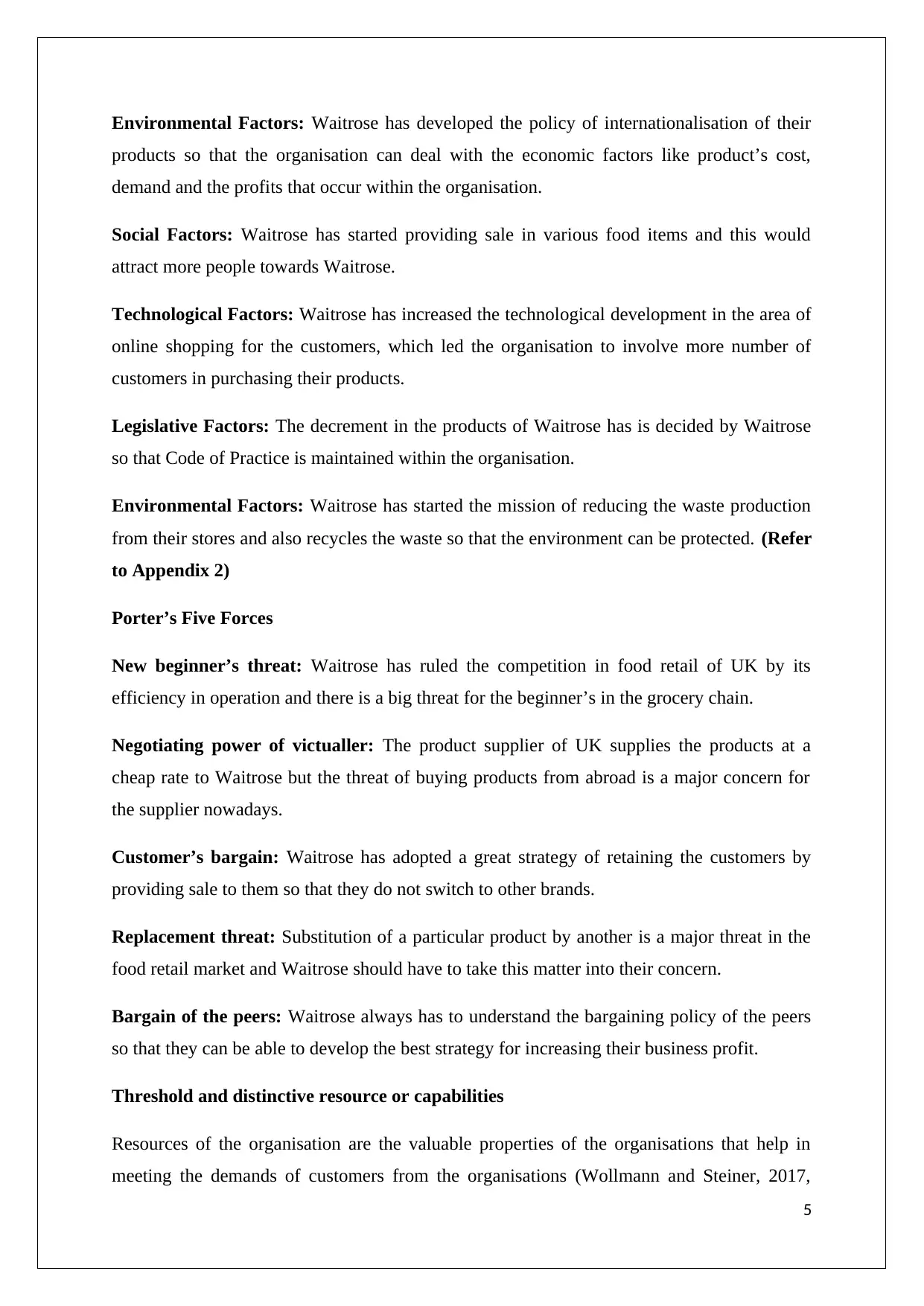
Environmental Factors: Waitrose has developed the policy of internationalisation of their
products so that the organisation can deal with the economic factors like product’s cost,
demand and the profits that occur within the organisation.
Social Factors: Waitrose has started providing sale in various food items and this would
attract more people towards Waitrose.
Technological Factors: Waitrose has increased the technological development in the area of
online shopping for the customers, which led the organisation to involve more number of
customers in purchasing their products.
Legislative Factors: The decrement in the products of Waitrose has is decided by Waitrose
so that Code of Practice is maintained within the organisation.
Environmental Factors: Waitrose has started the mission of reducing the waste production
from their stores and also recycles the waste so that the environment can be protected. (Refer
to Appendix 2)
Porter’s Five Forces
New beginner’s threat: Waitrose has ruled the competition in food retail of UK by its
efficiency in operation and there is a big threat for the beginner’s in the grocery chain.
Negotiating power of victualler: The product supplier of UK supplies the products at a
cheap rate to Waitrose but the threat of buying products from abroad is a major concern for
the supplier nowadays.
Customer’s bargain: Waitrose has adopted a great strategy of retaining the customers by
providing sale to them so that they do not switch to other brands.
Replacement threat: Substitution of a particular product by another is a major threat in the
food retail market and Waitrose should have to take this matter into their concern.
Bargain of the peers: Waitrose always has to understand the bargaining policy of the peers
so that they can be able to develop the best strategy for increasing their business profit.
Threshold and distinctive resource or capabilities
Resources of the organisation are the valuable properties of the organisations that help in
meeting the demands of customers from the organisations (Wollmann and Steiner, 2017,
5
products so that the organisation can deal with the economic factors like product’s cost,
demand and the profits that occur within the organisation.
Social Factors: Waitrose has started providing sale in various food items and this would
attract more people towards Waitrose.
Technological Factors: Waitrose has increased the technological development in the area of
online shopping for the customers, which led the organisation to involve more number of
customers in purchasing their products.
Legislative Factors: The decrement in the products of Waitrose has is decided by Waitrose
so that Code of Practice is maintained within the organisation.
Environmental Factors: Waitrose has started the mission of reducing the waste production
from their stores and also recycles the waste so that the environment can be protected. (Refer
to Appendix 2)
Porter’s Five Forces
New beginner’s threat: Waitrose has ruled the competition in food retail of UK by its
efficiency in operation and there is a big threat for the beginner’s in the grocery chain.
Negotiating power of victualler: The product supplier of UK supplies the products at a
cheap rate to Waitrose but the threat of buying products from abroad is a major concern for
the supplier nowadays.
Customer’s bargain: Waitrose has adopted a great strategy of retaining the customers by
providing sale to them so that they do not switch to other brands.
Replacement threat: Substitution of a particular product by another is a major threat in the
food retail market and Waitrose should have to take this matter into their concern.
Bargain of the peers: Waitrose always has to understand the bargaining policy of the peers
so that they can be able to develop the best strategy for increasing their business profit.
Threshold and distinctive resource or capabilities
Resources of the organisation are the valuable properties of the organisations that help in
meeting the demands of customers from the organisations (Wollmann and Steiner, 2017,
5
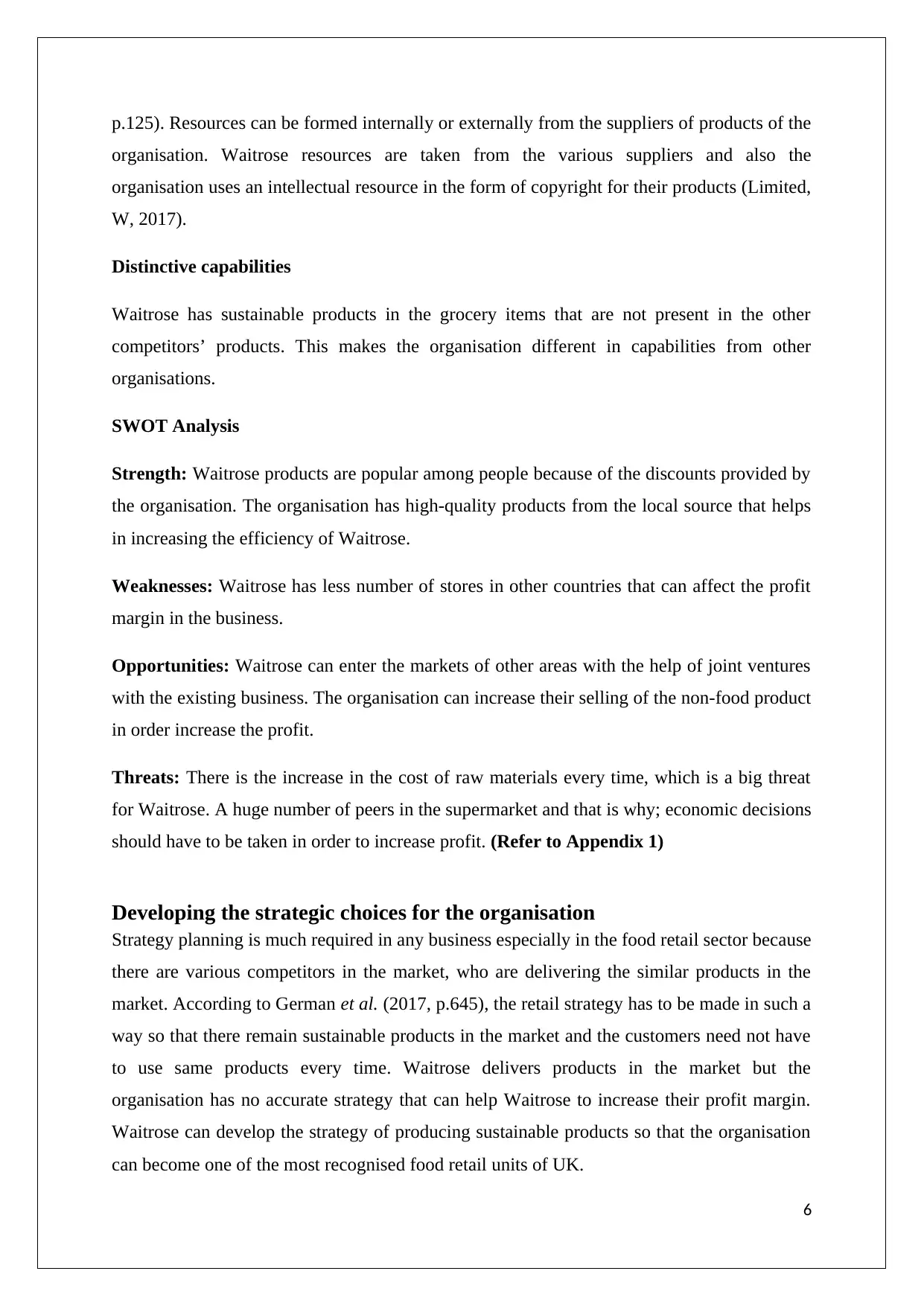
p.125). Resources can be formed internally or externally from the suppliers of products of the
organisation. Waitrose resources are taken from the various suppliers and also the
organisation uses an intellectual resource in the form of copyright for their products (Limited,
W, 2017).
Distinctive capabilities
Waitrose has sustainable products in the grocery items that are not present in the other
competitors’ products. This makes the organisation different in capabilities from other
organisations.
SWOT Analysis
Strength: Waitrose products are popular among people because of the discounts provided by
the organisation. The organisation has high-quality products from the local source that helps
in increasing the efficiency of Waitrose.
Weaknesses: Waitrose has less number of stores in other countries that can affect the profit
margin in the business.
Opportunities: Waitrose can enter the markets of other areas with the help of joint ventures
with the existing business. The organisation can increase their selling of the non-food product
in order increase the profit.
Threats: There is the increase in the cost of raw materials every time, which is a big threat
for Waitrose. A huge number of peers in the supermarket and that is why; economic decisions
should have to be taken in order to increase profit. (Refer to Appendix 1)
Developing the strategic choices for the organisation
Strategy planning is much required in any business especially in the food retail sector because
there are various competitors in the market, who are delivering the similar products in the
market. According to German et al. (2017, p.645), the retail strategy has to be made in such a
way so that there remain sustainable products in the market and the customers need not have
to use same products every time. Waitrose delivers products in the market but the
organisation has no accurate strategy that can help Waitrose to increase their profit margin.
Waitrose can develop the strategy of producing sustainable products so that the organisation
can become one of the most recognised food retail units of UK.
6
organisation. Waitrose resources are taken from the various suppliers and also the
organisation uses an intellectual resource in the form of copyright for their products (Limited,
W, 2017).
Distinctive capabilities
Waitrose has sustainable products in the grocery items that are not present in the other
competitors’ products. This makes the organisation different in capabilities from other
organisations.
SWOT Analysis
Strength: Waitrose products are popular among people because of the discounts provided by
the organisation. The organisation has high-quality products from the local source that helps
in increasing the efficiency of Waitrose.
Weaknesses: Waitrose has less number of stores in other countries that can affect the profit
margin in the business.
Opportunities: Waitrose can enter the markets of other areas with the help of joint ventures
with the existing business. The organisation can increase their selling of the non-food product
in order increase the profit.
Threats: There is the increase in the cost of raw materials every time, which is a big threat
for Waitrose. A huge number of peers in the supermarket and that is why; economic decisions
should have to be taken in order to increase profit. (Refer to Appendix 1)
Developing the strategic choices for the organisation
Strategy planning is much required in any business especially in the food retail sector because
there are various competitors in the market, who are delivering the similar products in the
market. According to German et al. (2017, p.645), the retail strategy has to be made in such a
way so that there remain sustainable products in the market and the customers need not have
to use same products every time. Waitrose delivers products in the market but the
organisation has no accurate strategy that can help Waitrose to increase their profit margin.
Waitrose can develop the strategy of producing sustainable products so that the organisation
can become one of the most recognised food retail units of UK.
6
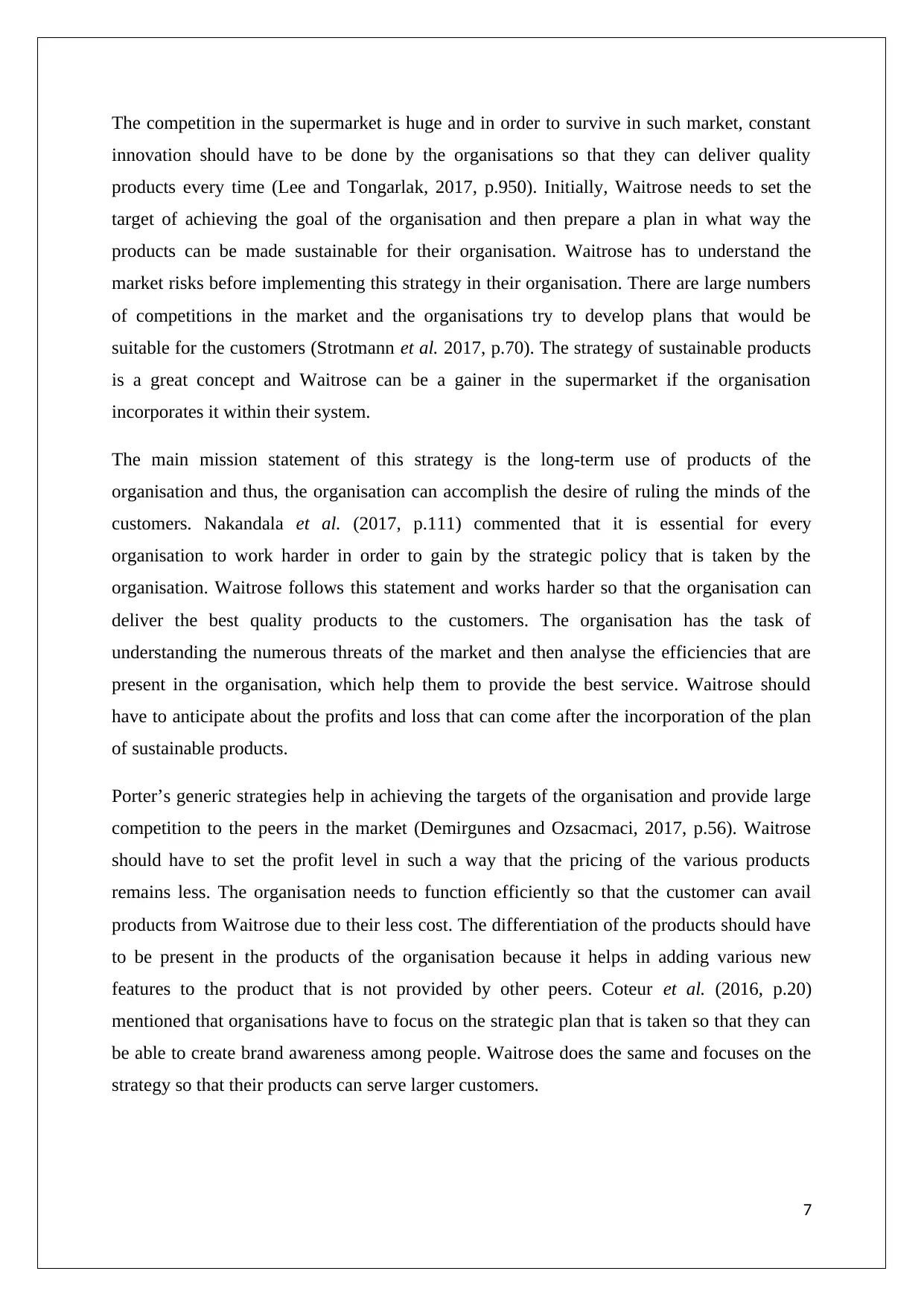
The competition in the supermarket is huge and in order to survive in such market, constant
innovation should have to be done by the organisations so that they can deliver quality
products every time (Lee and Tongarlak, 2017, p.950). Initially, Waitrose needs to set the
target of achieving the goal of the organisation and then prepare a plan in what way the
products can be made sustainable for their organisation. Waitrose has to understand the
market risks before implementing this strategy in their organisation. There are large numbers
of competitions in the market and the organisations try to develop plans that would be
suitable for the customers (Strotmann et al. 2017, p.70). The strategy of sustainable products
is a great concept and Waitrose can be a gainer in the supermarket if the organisation
incorporates it within their system.
The main mission statement of this strategy is the long-term use of products of the
organisation and thus, the organisation can accomplish the desire of ruling the minds of the
customers. Nakandala et al. (2017, p.111) commented that it is essential for every
organisation to work harder in order to gain by the strategic policy that is taken by the
organisation. Waitrose follows this statement and works harder so that the organisation can
deliver the best quality products to the customers. The organisation has the task of
understanding the numerous threats of the market and then analyse the efficiencies that are
present in the organisation, which help them to provide the best service. Waitrose should
have to anticipate about the profits and loss that can come after the incorporation of the plan
of sustainable products.
Porter’s generic strategies help in achieving the targets of the organisation and provide large
competition to the peers in the market (Demirgunes and Ozsacmaci, 2017, p.56). Waitrose
should have to set the profit level in such a way that the pricing of the various products
remains less. The organisation needs to function efficiently so that the customer can avail
products from Waitrose due to their less cost. The differentiation of the products should have
to be present in the products of the organisation because it helps in adding various new
features to the product that is not provided by other peers. Coteur et al. (2016, p.20)
mentioned that organisations have to focus on the strategic plan that is taken so that they can
be able to create brand awareness among people. Waitrose does the same and focuses on the
strategy so that their products can serve larger customers.
7
innovation should have to be done by the organisations so that they can deliver quality
products every time (Lee and Tongarlak, 2017, p.950). Initially, Waitrose needs to set the
target of achieving the goal of the organisation and then prepare a plan in what way the
products can be made sustainable for their organisation. Waitrose has to understand the
market risks before implementing this strategy in their organisation. There are large numbers
of competitions in the market and the organisations try to develop plans that would be
suitable for the customers (Strotmann et al. 2017, p.70). The strategy of sustainable products
is a great concept and Waitrose can be a gainer in the supermarket if the organisation
incorporates it within their system.
The main mission statement of this strategy is the long-term use of products of the
organisation and thus, the organisation can accomplish the desire of ruling the minds of the
customers. Nakandala et al. (2017, p.111) commented that it is essential for every
organisation to work harder in order to gain by the strategic policy that is taken by the
organisation. Waitrose follows this statement and works harder so that the organisation can
deliver the best quality products to the customers. The organisation has the task of
understanding the numerous threats of the market and then analyse the efficiencies that are
present in the organisation, which help them to provide the best service. Waitrose should
have to anticipate about the profits and loss that can come after the incorporation of the plan
of sustainable products.
Porter’s generic strategies help in achieving the targets of the organisation and provide large
competition to the peers in the market (Demirgunes and Ozsacmaci, 2017, p.56). Waitrose
should have to set the profit level in such a way that the pricing of the various products
remains less. The organisation needs to function efficiently so that the customer can avail
products from Waitrose due to their less cost. The differentiation of the products should have
to be present in the products of the organisation because it helps in adding various new
features to the product that is not provided by other peers. Coteur et al. (2016, p.20)
mentioned that organisations have to focus on the strategic plan that is taken so that they can
be able to create brand awareness among people. Waitrose does the same and focuses on the
strategy so that their products can serve larger customers.
7
Paraphrase This Document
Need a fresh take? Get an instant paraphrase of this document with our AI Paraphraser
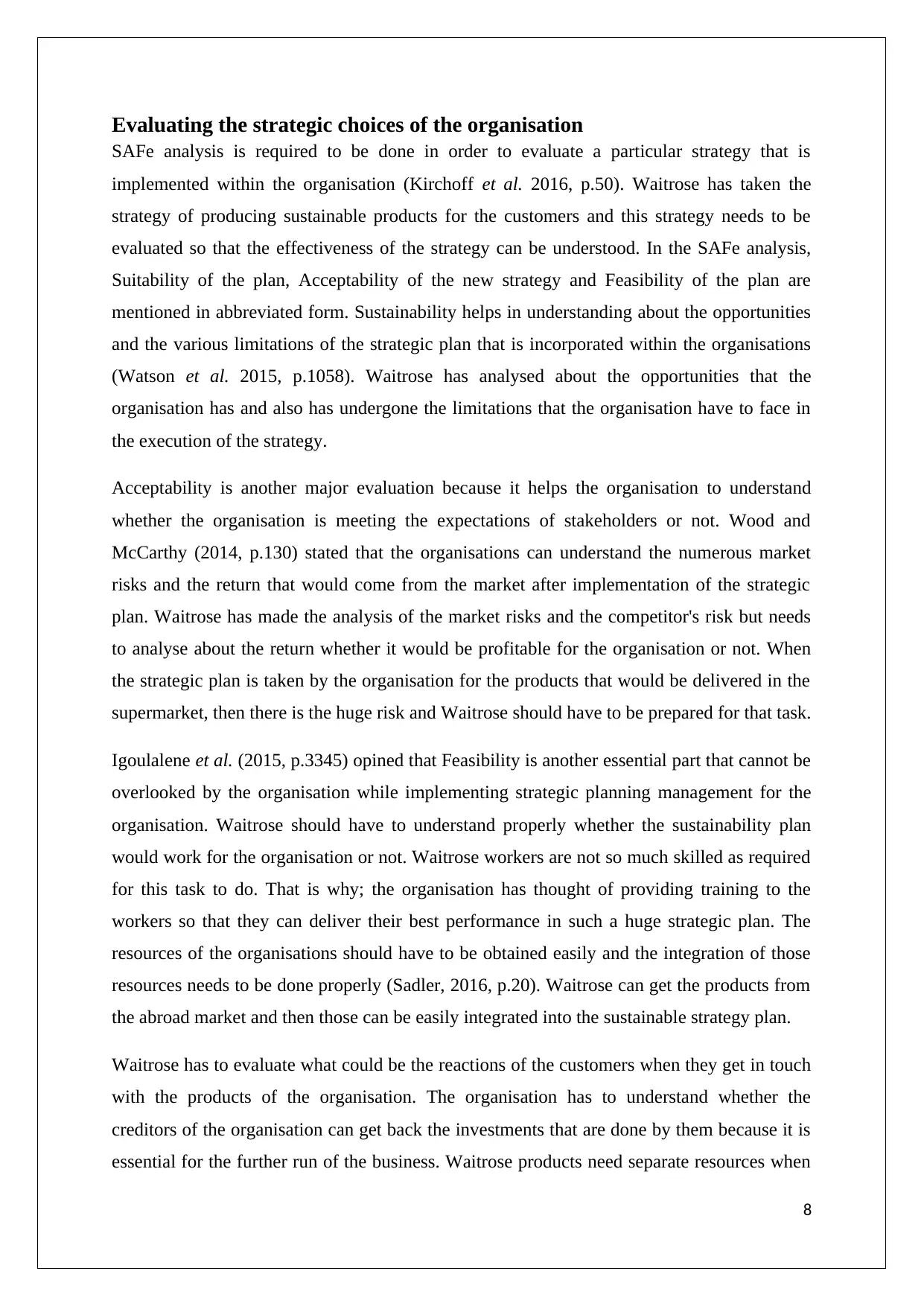
Evaluating the strategic choices of the organisation
SAFe analysis is required to be done in order to evaluate a particular strategy that is
implemented within the organisation (Kirchoff et al. 2016, p.50). Waitrose has taken the
strategy of producing sustainable products for the customers and this strategy needs to be
evaluated so that the effectiveness of the strategy can be understood. In the SAFe analysis,
Suitability of the plan, Acceptability of the new strategy and Feasibility of the plan are
mentioned in abbreviated form. Sustainability helps in understanding about the opportunities
and the various limitations of the strategic plan that is incorporated within the organisations
(Watson et al. 2015, p.1058). Waitrose has analysed about the opportunities that the
organisation has and also has undergone the limitations that the organisation have to face in
the execution of the strategy.
Acceptability is another major evaluation because it helps the organisation to understand
whether the organisation is meeting the expectations of stakeholders or not. Wood and
McCarthy (2014, p.130) stated that the organisations can understand the numerous market
risks and the return that would come from the market after implementation of the strategic
plan. Waitrose has made the analysis of the market risks and the competitor's risk but needs
to analyse about the return whether it would be profitable for the organisation or not. When
the strategic plan is taken by the organisation for the products that would be delivered in the
supermarket, then there is the huge risk and Waitrose should have to be prepared for that task.
Igoulalene et al. (2015, p.3345) opined that Feasibility is another essential part that cannot be
overlooked by the organisation while implementing strategic planning management for the
organisation. Waitrose should have to understand properly whether the sustainability plan
would work for the organisation or not. Waitrose workers are not so much skilled as required
for this task to do. That is why; the organisation has thought of providing training to the
workers so that they can deliver their best performance in such a huge strategic plan. The
resources of the organisations should have to be obtained easily and the integration of those
resources needs to be done properly (Sadler, 2016, p.20). Waitrose can get the products from
the abroad market and then those can be easily integrated into the sustainable strategy plan.
Waitrose has to evaluate what could be the reactions of the customers when they get in touch
with the products of the organisation. The organisation has to understand whether the
creditors of the organisation can get back the investments that are done by them because it is
essential for the further run of the business. Waitrose products need separate resources when
8
SAFe analysis is required to be done in order to evaluate a particular strategy that is
implemented within the organisation (Kirchoff et al. 2016, p.50). Waitrose has taken the
strategy of producing sustainable products for the customers and this strategy needs to be
evaluated so that the effectiveness of the strategy can be understood. In the SAFe analysis,
Suitability of the plan, Acceptability of the new strategy and Feasibility of the plan are
mentioned in abbreviated form. Sustainability helps in understanding about the opportunities
and the various limitations of the strategic plan that is incorporated within the organisations
(Watson et al. 2015, p.1058). Waitrose has analysed about the opportunities that the
organisation has and also has undergone the limitations that the organisation have to face in
the execution of the strategy.
Acceptability is another major evaluation because it helps the organisation to understand
whether the organisation is meeting the expectations of stakeholders or not. Wood and
McCarthy (2014, p.130) stated that the organisations can understand the numerous market
risks and the return that would come from the market after implementation of the strategic
plan. Waitrose has made the analysis of the market risks and the competitor's risk but needs
to analyse about the return whether it would be profitable for the organisation or not. When
the strategic plan is taken by the organisation for the products that would be delivered in the
supermarket, then there is the huge risk and Waitrose should have to be prepared for that task.
Igoulalene et al. (2015, p.3345) opined that Feasibility is another essential part that cannot be
overlooked by the organisation while implementing strategic planning management for the
organisation. Waitrose should have to understand properly whether the sustainability plan
would work for the organisation or not. Waitrose workers are not so much skilled as required
for this task to do. That is why; the organisation has thought of providing training to the
workers so that they can deliver their best performance in such a huge strategic plan. The
resources of the organisations should have to be obtained easily and the integration of those
resources needs to be done properly (Sadler, 2016, p.20). Waitrose can get the products from
the abroad market and then those can be easily integrated into the sustainable strategy plan.
Waitrose has to evaluate what could be the reactions of the customers when they get in touch
with the products of the organisation. The organisation has to understand whether the
creditors of the organisation can get back the investments that are done by them because it is
essential for the further run of the business. Waitrose products need separate resources when
8
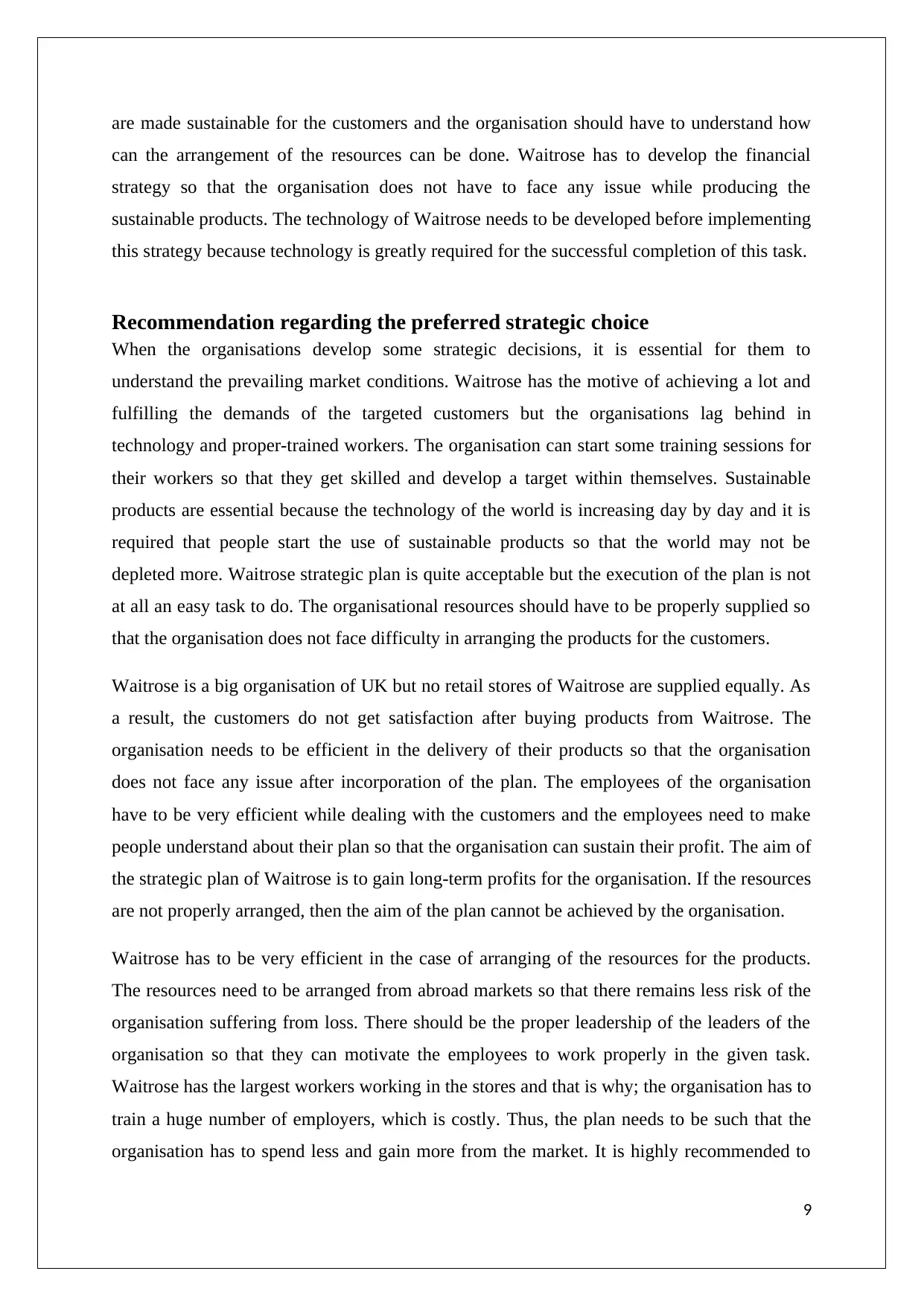
are made sustainable for the customers and the organisation should have to understand how
can the arrangement of the resources can be done. Waitrose has to develop the financial
strategy so that the organisation does not have to face any issue while producing the
sustainable products. The technology of Waitrose needs to be developed before implementing
this strategy because technology is greatly required for the successful completion of this task.
Recommendation regarding the preferred strategic choice
When the organisations develop some strategic decisions, it is essential for them to
understand the prevailing market conditions. Waitrose has the motive of achieving a lot and
fulfilling the demands of the targeted customers but the organisations lag behind in
technology and proper-trained workers. The organisation can start some training sessions for
their workers so that they get skilled and develop a target within themselves. Sustainable
products are essential because the technology of the world is increasing day by day and it is
required that people start the use of sustainable products so that the world may not be
depleted more. Waitrose strategic plan is quite acceptable but the execution of the plan is not
at all an easy task to do. The organisational resources should have to be properly supplied so
that the organisation does not face difficulty in arranging the products for the customers.
Waitrose is a big organisation of UK but no retail stores of Waitrose are supplied equally. As
a result, the customers do not get satisfaction after buying products from Waitrose. The
organisation needs to be efficient in the delivery of their products so that the organisation
does not face any issue after incorporation of the plan. The employees of the organisation
have to be very efficient while dealing with the customers and the employees need to make
people understand about their plan so that the organisation can sustain their profit. The aim of
the strategic plan of Waitrose is to gain long-term profits for the organisation. If the resources
are not properly arranged, then the aim of the plan cannot be achieved by the organisation.
Waitrose has to be very efficient in the case of arranging of the resources for the products.
The resources need to be arranged from abroad markets so that there remains less risk of the
organisation suffering from loss. There should be the proper leadership of the leaders of the
organisation so that they can motivate the employees to work properly in the given task.
Waitrose has the largest workers working in the stores and that is why; the organisation has to
train a huge number of employers, which is costly. Thus, the plan needs to be such that the
organisation has to spend less and gain more from the market. It is highly recommended to
9
can the arrangement of the resources can be done. Waitrose has to develop the financial
strategy so that the organisation does not have to face any issue while producing the
sustainable products. The technology of Waitrose needs to be developed before implementing
this strategy because technology is greatly required for the successful completion of this task.
Recommendation regarding the preferred strategic choice
When the organisations develop some strategic decisions, it is essential for them to
understand the prevailing market conditions. Waitrose has the motive of achieving a lot and
fulfilling the demands of the targeted customers but the organisations lag behind in
technology and proper-trained workers. The organisation can start some training sessions for
their workers so that they get skilled and develop a target within themselves. Sustainable
products are essential because the technology of the world is increasing day by day and it is
required that people start the use of sustainable products so that the world may not be
depleted more. Waitrose strategic plan is quite acceptable but the execution of the plan is not
at all an easy task to do. The organisational resources should have to be properly supplied so
that the organisation does not face difficulty in arranging the products for the customers.
Waitrose is a big organisation of UK but no retail stores of Waitrose are supplied equally. As
a result, the customers do not get satisfaction after buying products from Waitrose. The
organisation needs to be efficient in the delivery of their products so that the organisation
does not face any issue after incorporation of the plan. The employees of the organisation
have to be very efficient while dealing with the customers and the employees need to make
people understand about their plan so that the organisation can sustain their profit. The aim of
the strategic plan of Waitrose is to gain long-term profits for the organisation. If the resources
are not properly arranged, then the aim of the plan cannot be achieved by the organisation.
Waitrose has to be very efficient in the case of arranging of the resources for the products.
The resources need to be arranged from abroad markets so that there remains less risk of the
organisation suffering from loss. There should be the proper leadership of the leaders of the
organisation so that they can motivate the employees to work properly in the given task.
Waitrose has the largest workers working in the stores and that is why; the organisation has to
train a huge number of employers, which is costly. Thus, the plan needs to be such that the
organisation has to spend less and gain more from the market. It is highly recommended to
9
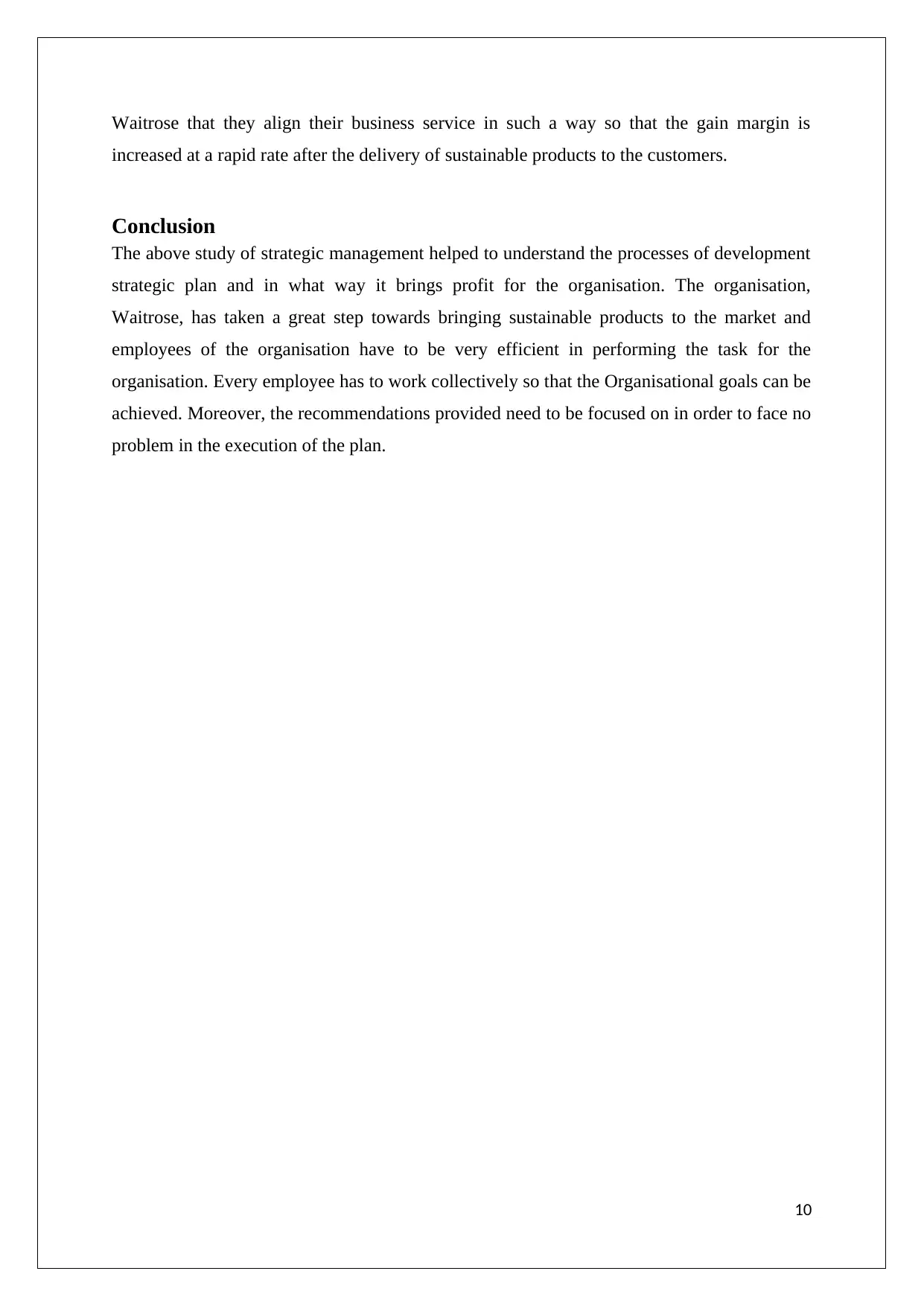
Waitrose that they align their business service in such a way so that the gain margin is
increased at a rapid rate after the delivery of sustainable products to the customers.
Conclusion
The above study of strategic management helped to understand the processes of development
strategic plan and in what way it brings profit for the organisation. The organisation,
Waitrose, has taken a great step towards bringing sustainable products to the market and
employees of the organisation have to be very efficient in performing the task for the
organisation. Every employee has to work collectively so that the Organisational goals can be
achieved. Moreover, the recommendations provided need to be focused on in order to face no
problem in the execution of the plan.
10
increased at a rapid rate after the delivery of sustainable products to the customers.
Conclusion
The above study of strategic management helped to understand the processes of development
strategic plan and in what way it brings profit for the organisation. The organisation,
Waitrose, has taken a great step towards bringing sustainable products to the market and
employees of the organisation have to be very efficient in performing the task for the
organisation. Every employee has to work collectively so that the Organisational goals can be
achieved. Moreover, the recommendations provided need to be focused on in order to face no
problem in the execution of the plan.
10
Secure Best Marks with AI Grader
Need help grading? Try our AI Grader for instant feedback on your assignments.
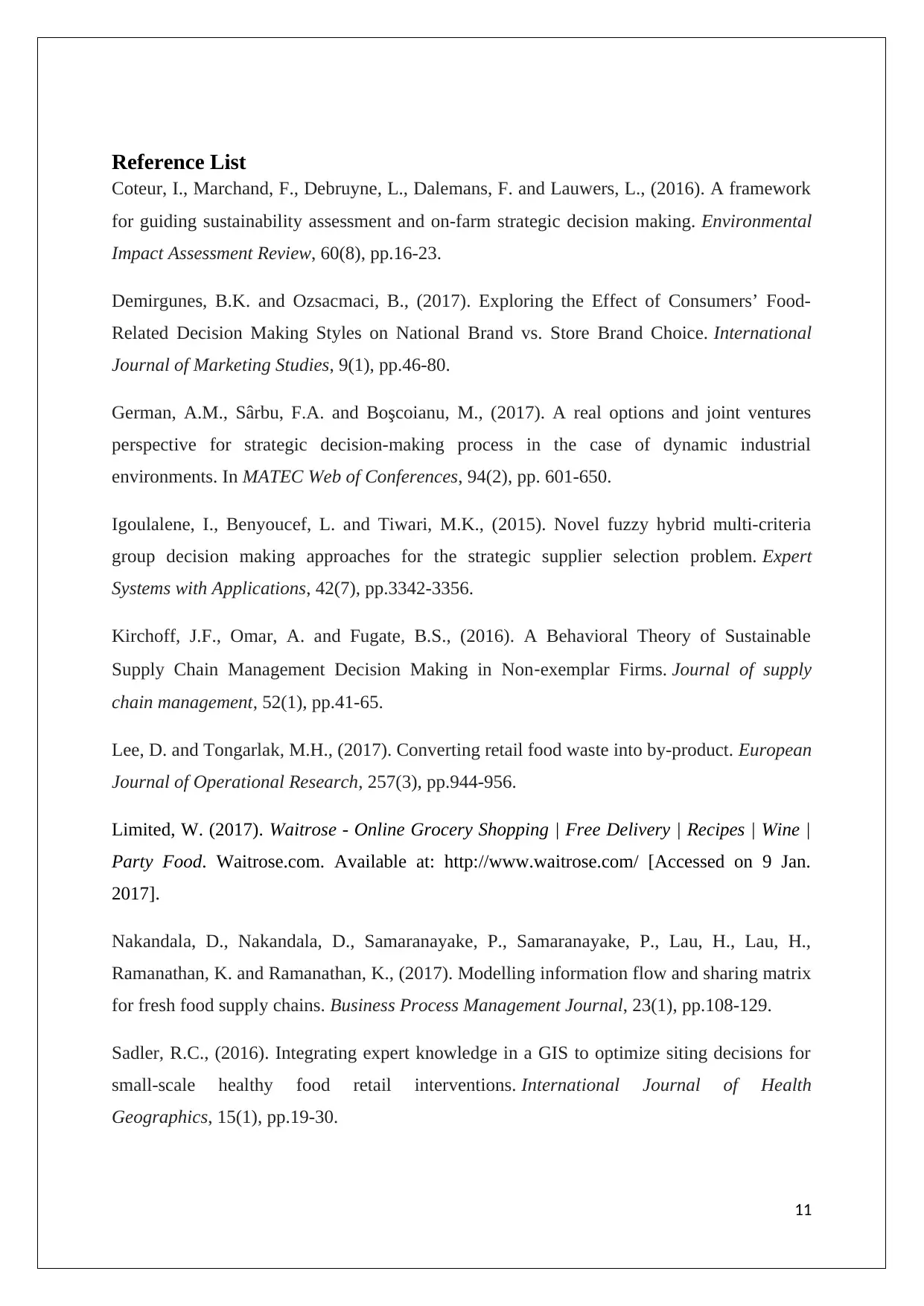
Reference List
Coteur, I., Marchand, F., Debruyne, L., Dalemans, F. and Lauwers, L., (2016). A framework
for guiding sustainability assessment and on-farm strategic decision making. Environmental
Impact Assessment Review, 60(8), pp.16-23.
Demirgunes, B.K. and Ozsacmaci, B., (2017). Exploring the Effect of Consumers’ Food-
Related Decision Making Styles on National Brand vs. Store Brand Choice. International
Journal of Marketing Studies, 9(1), pp.46-80.
German, A.M., Sârbu, F.A. and Boşcoianu, M., (2017). A real options and joint ventures
perspective for strategic decision-making process in the case of dynamic industrial
environments. In MATEC Web of Conferences, 94(2), pp. 601-650.
Igoulalene, I., Benyoucef, L. and Tiwari, M.K., (2015). Novel fuzzy hybrid multi-criteria
group decision making approaches for the strategic supplier selection problem. Expert
Systems with Applications, 42(7), pp.3342-3356.
Kirchoff, J.F., Omar, A. and Fugate, B.S., (2016). A Behavioral Theory of Sustainable
Supply Chain Management Decision Making in Non‐exemplar Firms. Journal of supply
chain management, 52(1), pp.41-65.
Lee, D. and Tongarlak, M.H., (2017). Converting retail food waste into by-product. European
Journal of Operational Research, 257(3), pp.944-956.
Limited, W. (2017). Waitrose - Online Grocery Shopping | Free Delivery | Recipes | Wine |
Party Food. Waitrose.com. Available at: http://www.waitrose.com/ [Accessed on 9 Jan.
2017].
Nakandala, D., Nakandala, D., Samaranayake, P., Samaranayake, P., Lau, H., Lau, H.,
Ramanathan, K. and Ramanathan, K., (2017). Modelling information flow and sharing matrix
for fresh food supply chains. Business Process Management Journal, 23(1), pp.108-129.
Sadler, R.C., (2016). Integrating expert knowledge in a GIS to optimize siting decisions for
small-scale healthy food retail interventions. International Journal of Health
Geographics, 15(1), pp.19-30.
11
Coteur, I., Marchand, F., Debruyne, L., Dalemans, F. and Lauwers, L., (2016). A framework
for guiding sustainability assessment and on-farm strategic decision making. Environmental
Impact Assessment Review, 60(8), pp.16-23.
Demirgunes, B.K. and Ozsacmaci, B., (2017). Exploring the Effect of Consumers’ Food-
Related Decision Making Styles on National Brand vs. Store Brand Choice. International
Journal of Marketing Studies, 9(1), pp.46-80.
German, A.M., Sârbu, F.A. and Boşcoianu, M., (2017). A real options and joint ventures
perspective for strategic decision-making process in the case of dynamic industrial
environments. In MATEC Web of Conferences, 94(2), pp. 601-650.
Igoulalene, I., Benyoucef, L. and Tiwari, M.K., (2015). Novel fuzzy hybrid multi-criteria
group decision making approaches for the strategic supplier selection problem. Expert
Systems with Applications, 42(7), pp.3342-3356.
Kirchoff, J.F., Omar, A. and Fugate, B.S., (2016). A Behavioral Theory of Sustainable
Supply Chain Management Decision Making in Non‐exemplar Firms. Journal of supply
chain management, 52(1), pp.41-65.
Lee, D. and Tongarlak, M.H., (2017). Converting retail food waste into by-product. European
Journal of Operational Research, 257(3), pp.944-956.
Limited, W. (2017). Waitrose - Online Grocery Shopping | Free Delivery | Recipes | Wine |
Party Food. Waitrose.com. Available at: http://www.waitrose.com/ [Accessed on 9 Jan.
2017].
Nakandala, D., Nakandala, D., Samaranayake, P., Samaranayake, P., Lau, H., Lau, H.,
Ramanathan, K. and Ramanathan, K., (2017). Modelling information flow and sharing matrix
for fresh food supply chains. Business Process Management Journal, 23(1), pp.108-129.
Sadler, R.C., (2016). Integrating expert knowledge in a GIS to optimize siting decisions for
small-scale healthy food retail interventions. International Journal of Health
Geographics, 15(1), pp.19-30.
11
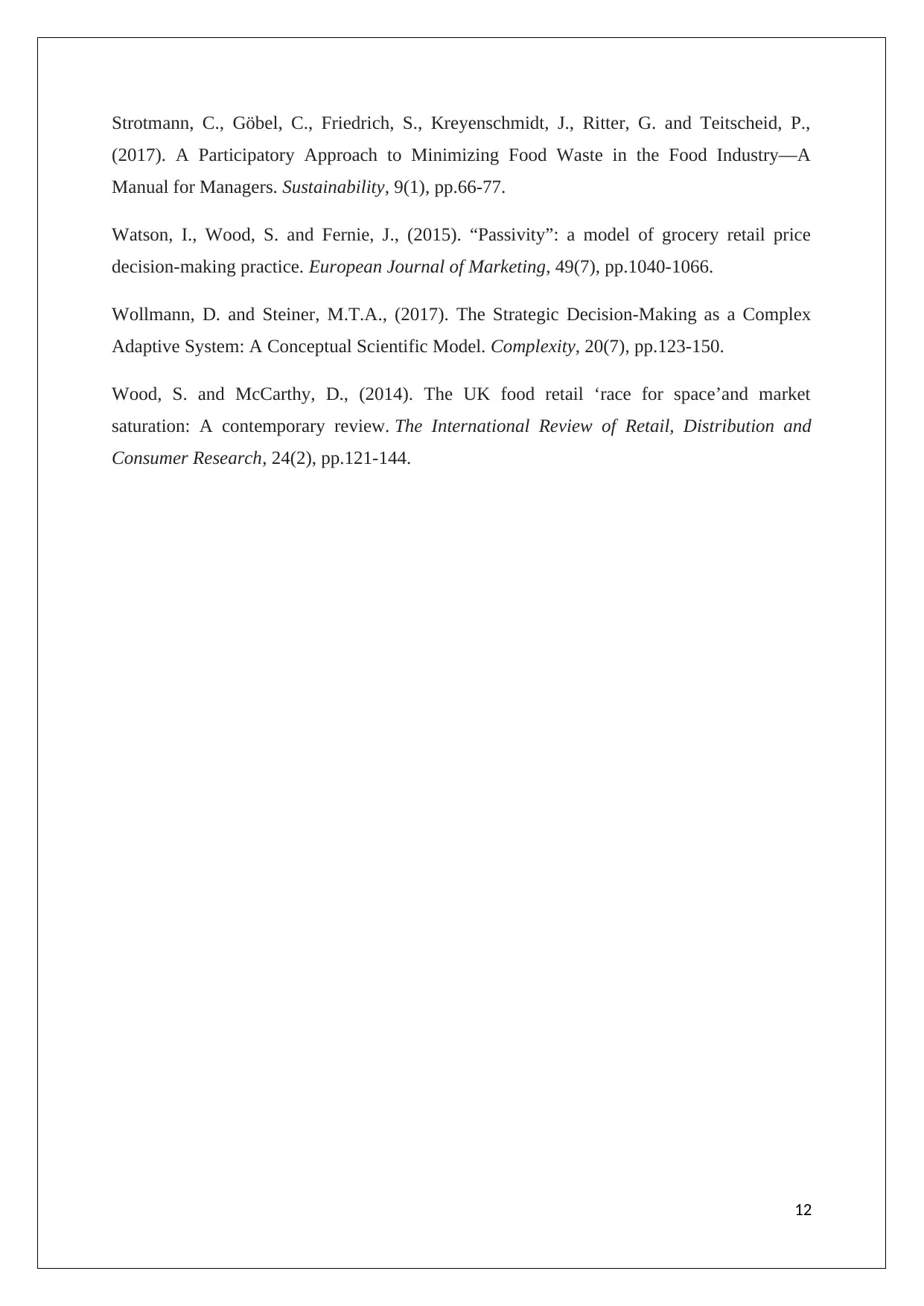
Strotmann, C., Göbel, C., Friedrich, S., Kreyenschmidt, J., Ritter, G. and Teitscheid, P.,
(2017). A Participatory Approach to Minimizing Food Waste in the Food Industry—A
Manual for Managers. Sustainability, 9(1), pp.66-77.
Watson, I., Wood, S. and Fernie, J., (2015). “Passivity”: a model of grocery retail price
decision-making practice. European Journal of Marketing, 49(7), pp.1040-1066.
Wollmann, D. and Steiner, M.T.A., (2017). The Strategic Decision-Making as a Complex
Adaptive System: A Conceptual Scientific Model. Complexity, 20(7), pp.123-150.
Wood, S. and McCarthy, D., (2014). The UK food retail ‘race for space’and market
saturation: A contemporary review. The International Review of Retail, Distribution and
Consumer Research, 24(2), pp.121-144.
12
(2017). A Participatory Approach to Minimizing Food Waste in the Food Industry—A
Manual for Managers. Sustainability, 9(1), pp.66-77.
Watson, I., Wood, S. and Fernie, J., (2015). “Passivity”: a model of grocery retail price
decision-making practice. European Journal of Marketing, 49(7), pp.1040-1066.
Wollmann, D. and Steiner, M.T.A., (2017). The Strategic Decision-Making as a Complex
Adaptive System: A Conceptual Scientific Model. Complexity, 20(7), pp.123-150.
Wood, S. and McCarthy, D., (2014). The UK food retail ‘race for space’and market
saturation: A contemporary review. The International Review of Retail, Distribution and
Consumer Research, 24(2), pp.121-144.
12

Appendices
Appendix 1: (SWOT Analysis)
Appendix 2: (PESTLE Analysis)
13
Appendix 1: (SWOT Analysis)
Appendix 2: (PESTLE Analysis)
13
1 out of 13
Related Documents
Your All-in-One AI-Powered Toolkit for Academic Success.
+13062052269
info@desklib.com
Available 24*7 on WhatsApp / Email
![[object Object]](/_next/static/media/star-bottom.7253800d.svg)
Unlock your academic potential
© 2024 | Zucol Services PVT LTD | All rights reserved.





